Roast Leg of Lamb: A Festive Roast With Perfect Temps
There is no smell in the world quite like roast lamb. It has all the meaty richness of beef but with an added hit of something undefinable and intoxicating. It has a spicy, heady primalness to it that I think evokes a wilder way of eating than what we in America tend to cling to. At least, it does to my nose.
Lamb is easily my favorite meat—which is saying something considering that beef is in the running!—because of that special lamby quality.And a roasted joint of lamb is a jewel on any table, but particularly at Easter!
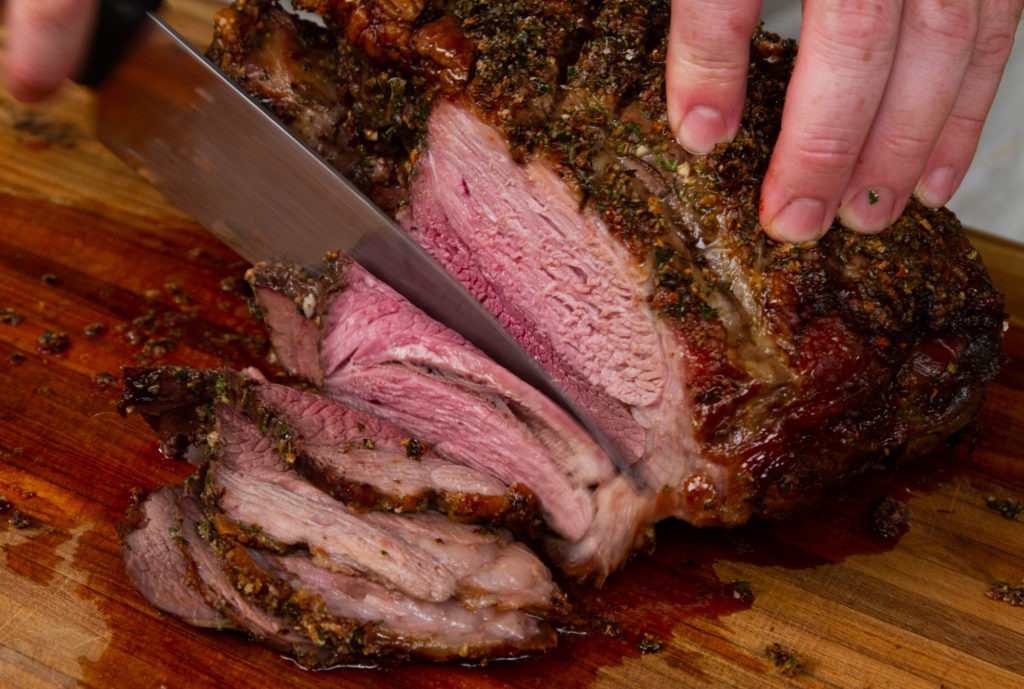
So today we’re bringing you a great recipe from our friends at Epicurious.com and some instruction on how to properly cook a leg of lamb so that you get the very best result possible. The key? A quality leave-in thermometer like the ChefAlarm® tracking your internal temperatures while you roast, of course!
Thermal Principles: Lamb Temperature
Lamb is often served on the rare side, seldom passing medium rare, 130–35°F (54–57°C). How can we get there?
We’re looking for a nice crusty finish on the outside of the roast—everyone loves those edge pieces on a good roast!—so we can’t cook it too slowly. But it’s a large piece of meat, so cooking it in too hot an oven will push our temperature gradients too far and overcook the majority of the roast before the inside is done cooking.
As a compromise, we’ll cook this roast at 350°F (177°C), a good temperature between crisping high and slow-cooking low temperatures. At 350°F (177°C), a roast this size is going to experience 7–10°F (4–6°C) of carryover cooking, meaning we should set our high alarm on our ChefAlarm about 10°F (6°C) lower than our desired final doneness temperature. We like 125°F (52°C) for our pull temp. Of course, you should always verify any pull temps that you may get from your ChefAlarm with your Thermapen® to be sure your probe was actually in the thermal center of your roast.
Once your lamb reaches your pull temperature, you need to let it rest for at least 15 minutes on the counter before carving. The rest will give the muscle fibers in the lamb time to relax and reabsorb any juices they will have expelled during cooking.
Bone in or Boneless Leg of Lamb?
The question often comes up, should you cook a boneless or bone-in leg of lamb? In truth, there are advantages to both sides. A boneless leg is faster cooking (there’s just less mass to heat), and, in many areas, easier to find. It also provides for hassle-free carving, which is nice.
A bone-in leg, however, gives you a picture perfect, traditional presentation for you dinner. Plus you get a meaty lamb bone after you’re done that you can use to make a delicious stock out of. Some people insist the bone adds flavor to the roast, but the evidence for that is flimsy, at best. All in all, I do prefer the bone-in leg, and that’s what we’ll be using in this post.
Whether you choose the leg with or without the bone, the cooking method is the same: season the leg of lamb and cook it to 125°F (52°C) using a leave-in thermometer. Just know that a boneless leg will take less time.
Lamb and Mint Jelly: Heresy or Necessity?
Serving lamb with mint jelly is a long-standing tradition that is ingrained in the minds of many Americans. In their minds, mint jelly is to the lamb what cranberry sauce it to turkey, what horseradish is to roast beef. I tend to agree, in a way. For cranberry sauce, I prefer to make my own, eschewing the canned version. I also prefer to make horseradish sauce myself, not buying pre-made creamy horseradish. So with mint and lamb.
Green wobbly mint jelly is delicious, it’s true, but I feel like a juicy, crusty, savory leg of lamb that has been roasted to perfection deserves something better than cloyingly sweet green jelly And to that end we’re also including a recipe for a traditional mint sauce to serve with your lamb. It’s dead simple to make and the vinegar in it is bright and refreshing against the rich, delicious fattiness of the lamb leg. Of course, if you choose the traditional green jelly, no one will look askance at you for it!
Roast Leg of Lamb Recipe
Ingredients
For the lamb
Based on the recipe from Epicurious.com
- 1 (7-pound) semi-boneless leg of lamb, aitchbone removed (ask the butcher to do this for you), fat trimmed to 1/4 inch thick
- 4 garlic cloves
- 1 Tbsp kosher salt
- 2 Tbsp chopped fresh rosemary
- 2 Tbsp fresh chopped parsley
- 2 tsp lemon zest
- ½ tsp black pepper
- ¼ C dry red wine or beef broth
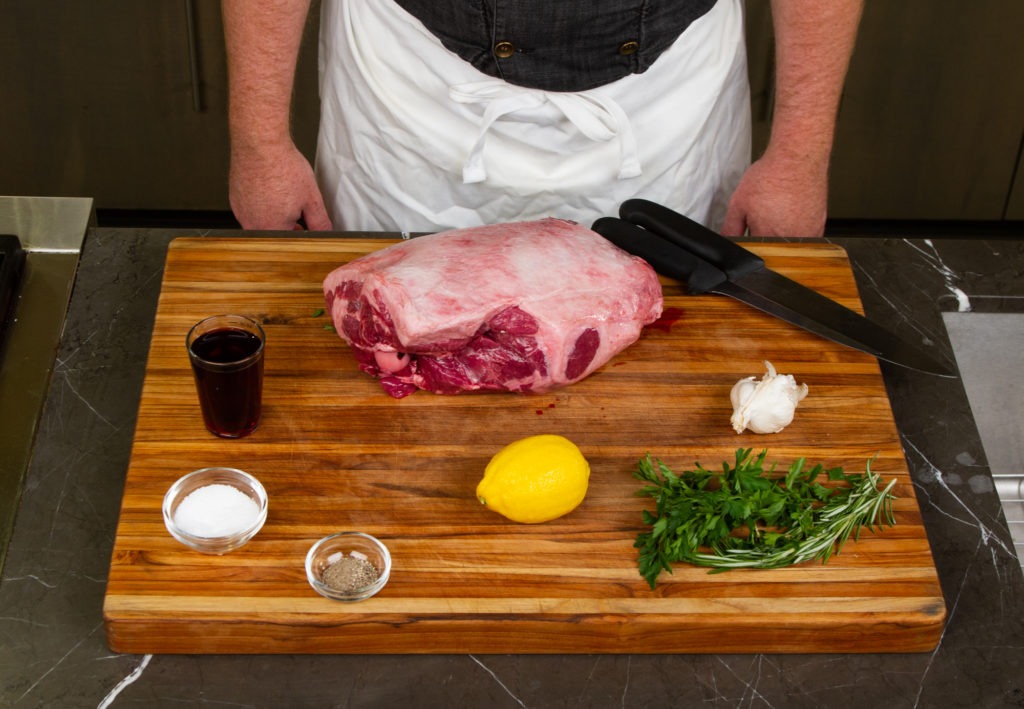
For the mint sauce
Based on the recipe from Saveur
- 2¼ C mint leaves, finely chopped
- 1 Tbsp sugar
- ½ tsp kosher salt
- ¼ C boiling water
- 1 C white vinegar
Instructions
Prepare the lamb
- Pat the lamb dry and score the fat with a sharp knife.
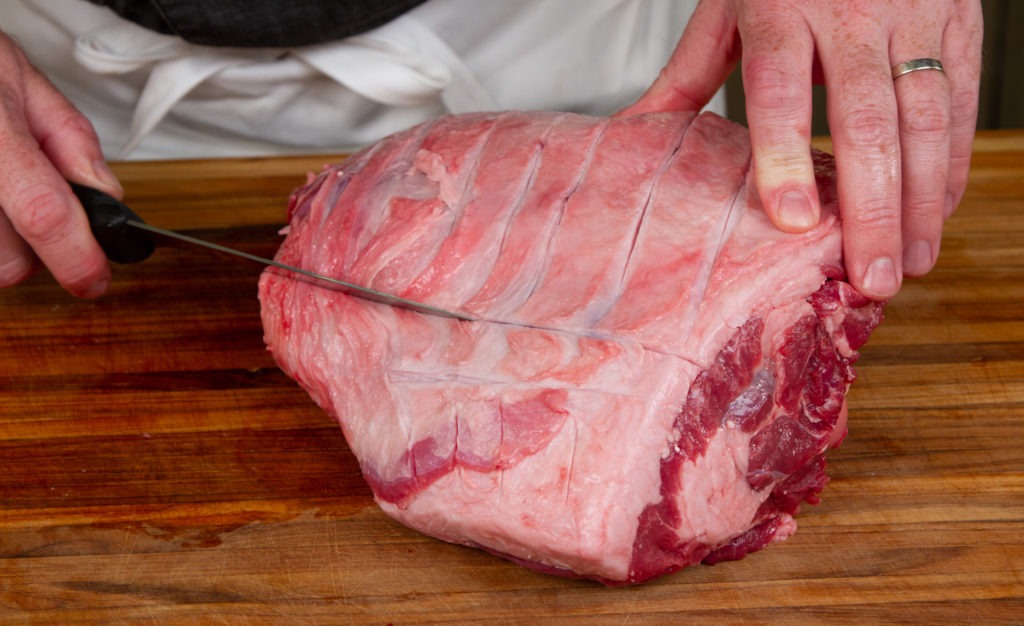
- Mince the garlic to a paste with sea salt and stir it together with the salt, parsley, lemon zest, rosemary and pepper.

- Rub the herb and garlic mixture all over the lamb, pressing it into the scored fat.

- Put lamb on a lightly oiled sheet tray or in a roasting pan. Let the meat stand at room temperature 30 minutes.
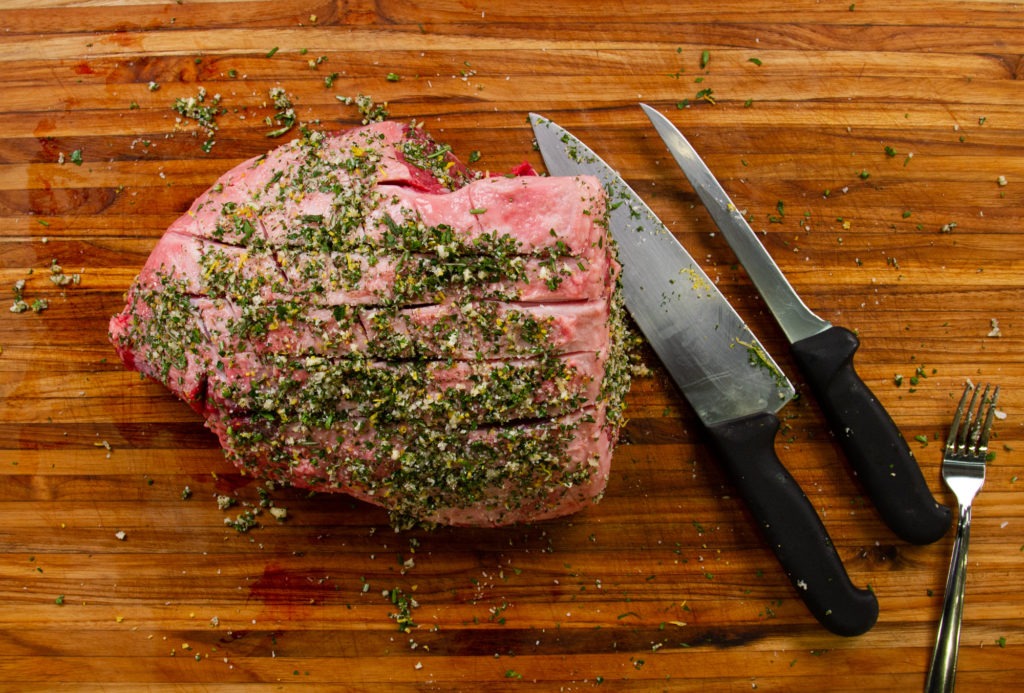
- Preheat oven to 350°F and prepare the mint sauce.
Prepare mint sauce
- Combine the minced mint, sugar, and salt in a bowl.
- Add the boiling water and stir to dissolve the sugar and salt. (It will look like a bunch of wet leaves.)
- Add the vinegar, stir to combine and let the sauce sit for an hour to let the flavors combine.

Cook the lamb
- Insert the probe of your ChefAlarm into the deepest part of the roast. Set the high alarm for 125°F (52°C) and place the roast in the oven.
- Roast the lamb until it reaches the pull temp of 125°F (52°C) and the ChefAlarm beeps, about 1½ hours.

- When the alarm sounds, verify that 125°F (52°C) is, indeed, the lowest internal temperature with a Thermapen® instant read thermometer. If you see a lower number, reposition your ChefAlarm probe (if you like, being careful not to touch the hot metal probe directly), and continue cooking ’til done.

- Allow the lamb to rest for 15-25 minutes before carving. The internal temperature will rise 7–10°F (4–6°C) during the rest.
- While the lamb rests, make the pan sauce by placing the pan over a hot burner and adding the wine or stock to deglaze it. Scrape up all the brown bits form the pan and cook the sauce to reduce it slightly, about a minute. If needed (but it probably won’t be), season pan juices with salt and pepper.

- Carve the lamb by cutting a flat base onto the less-meaty side, then stand the lamb on that base. Cut sliced perpendicular to the bone, then cut along the bone to remove those slices. The rest of the meat from the bone in chunks and slice.

- Serve the lamb with the wine sauce and the mint sauce
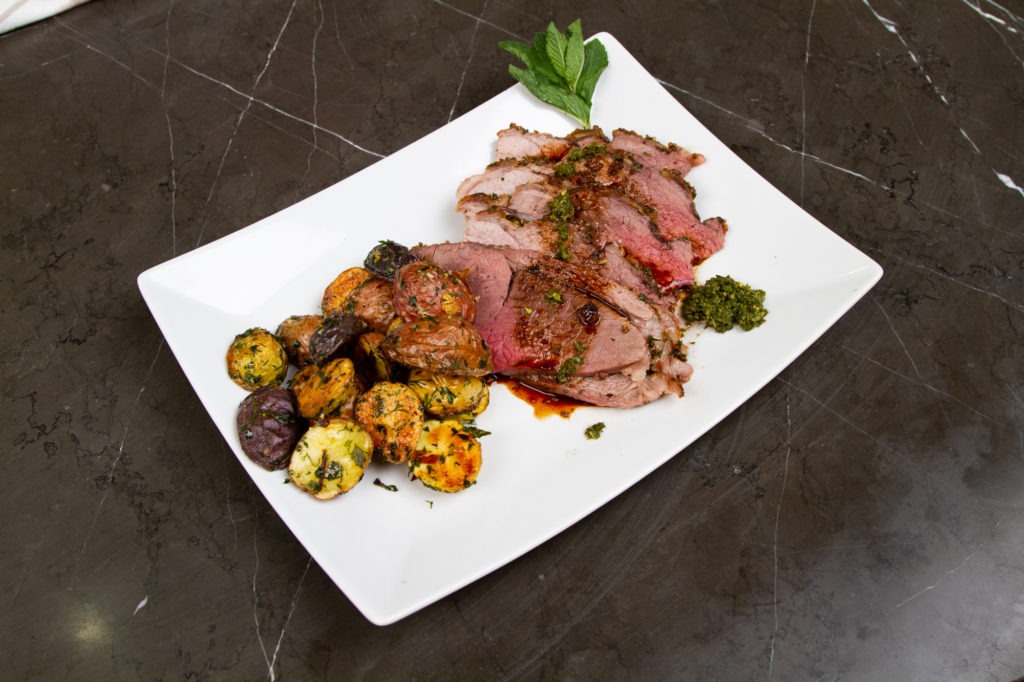
Whether for Easter or any other celebration, there’s nothing like a savory, juicy leg of lamb. Tender, pink slices of lamb, splashed in a rich pan sauce and nestled among roasted potatoes is a beautiful sight on a plate and is easy to achieve if you use your ChefAlarm and Thermapen® to get ensure a perfect doneness. Try it out and let us know how it goes (and whether you love or hate green mint jelly) in the comments section below!
Shop now for products used in this post:


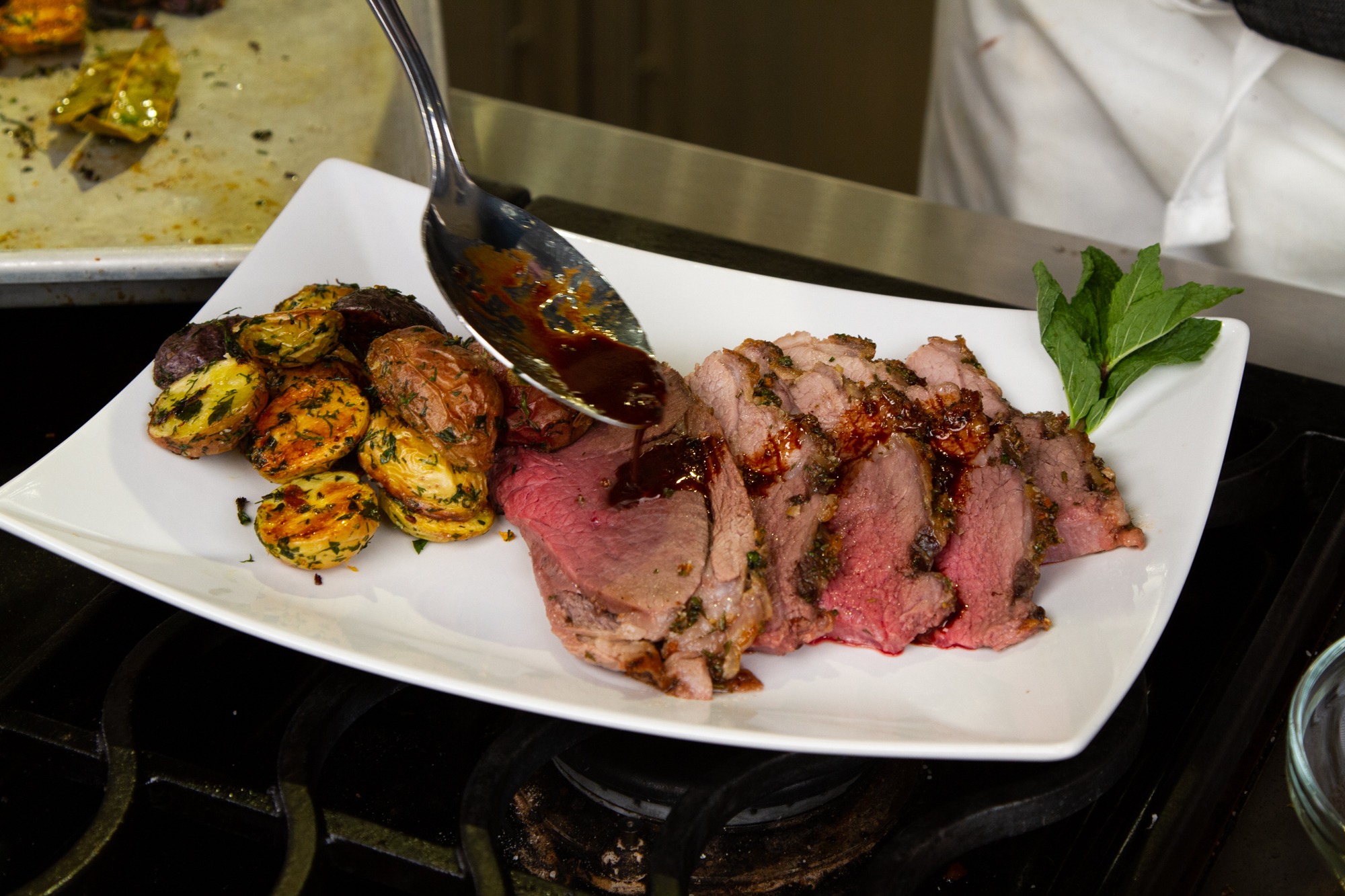
Is the optimal oven temperature and internal pull point temperature for roast Leg of Lamb different for roast Rack of Lamb (loin)?
Louis,
The pull temp is the same, but the cook temp is different. the oven temp for rack of lamb is usually high, around 425°F. A higher temperature is ok because there isn’t as much meat to cook through—there’s less chance of overcooking the outside before the inside is done.
I hope that helps!
Two tips for better lamb. One, get the best lamb you can buy. Farmers market lamb usually beats supermarket lamb. If you cook lamb often, you may get even pickier and find that certain farmers have better lamb than others. Ask around — you might get a tip from a fellow shopper. Two, trim the fat aggressively before you roast. The more you trim, the milder the taste. Some people who say they don’t like lamb because of the musky taste find that they love lamb that had the fat well-trimmed before cooking.
That’s because it’s Australian lamb! American lamb is sweeter and the best lamb comes out of Colorado!
I lived in lamb country in Craig colo. Best lamb
My mother always made this, alittle different but always good and filling, especially when you have alot to feed! This is one of my favorite dishes.I love all your recipes. They are good and easy to make.
Regarding mint jelly, I LOVE IT! (Of course I have a sweet tooth). I once cooked a leg of lamb using hoisin sauce with garlic and herbs. I covered it with hoisin sauce and roasted it for most of the cooking time and finished it on the grill basting it with hoisin sauce. It was delicious, but I haven’t done that since I moved. (My grill was in a more convenient place at that home).